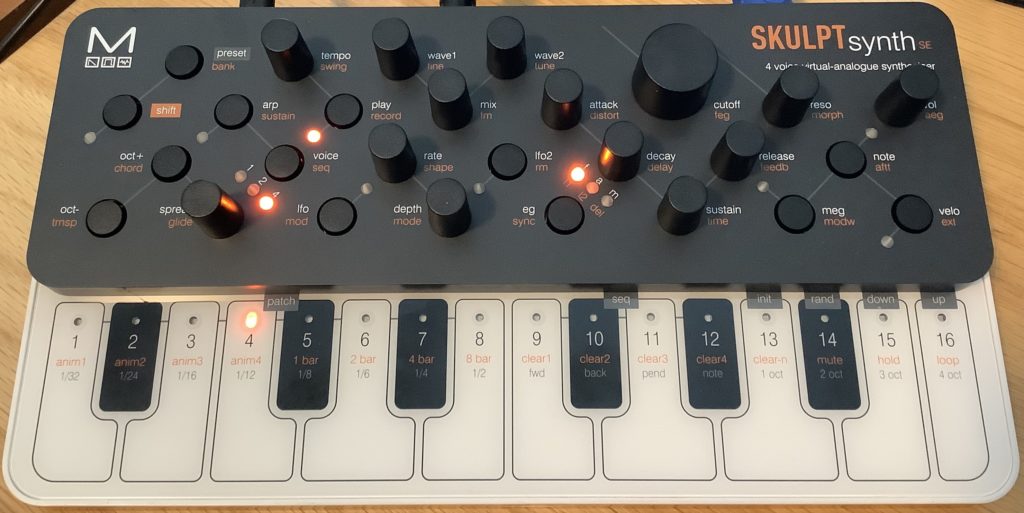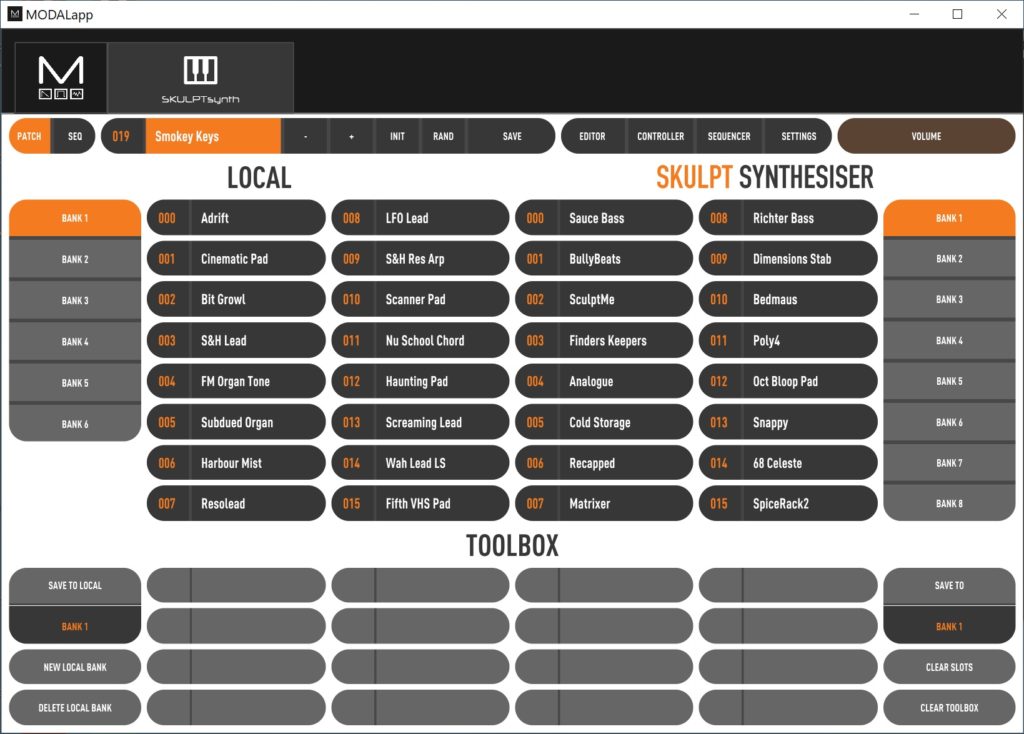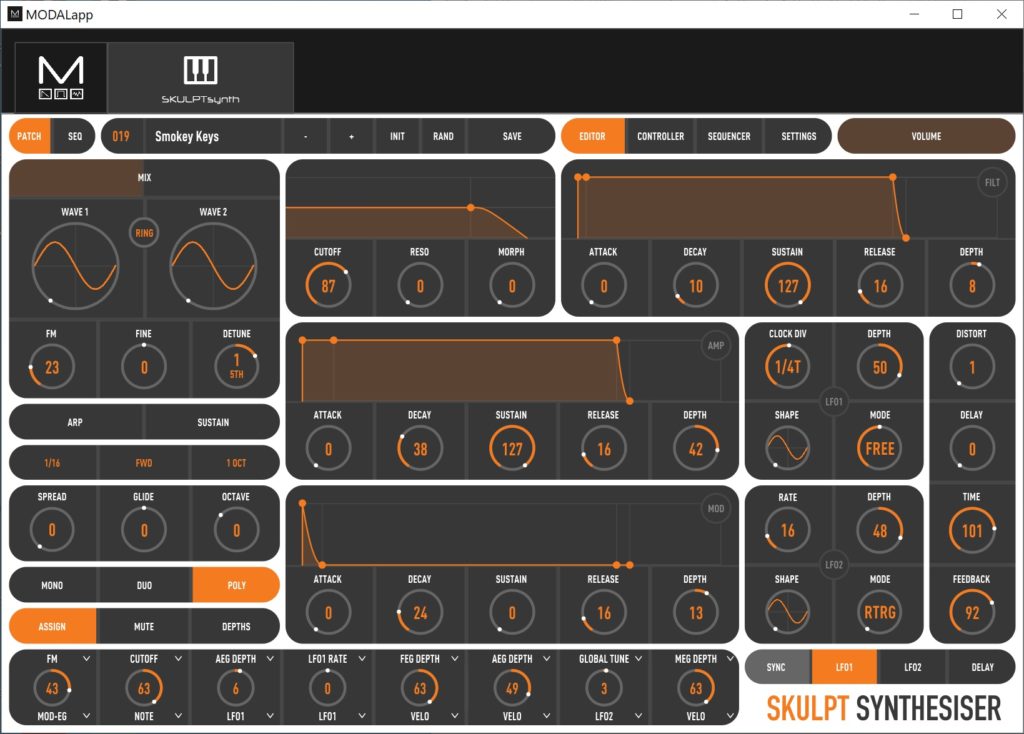True to their word, Modal Electronics are shipping the first Skulpt SE virtual analog modules, and I’ve got one. Initial impressions…
Arrival
The Modal Skulpt SE arrives in a neat brown box, well-protected from the strains of travel through the package delivery system. With the pandemic all about, most of us are buying on-line and good packing is important!

Inside are the Modal Skulpt SE (henceforth, the “SE”), a “UI combinations” card for a quick start, and a moderately short micro USB cable. If you intend to run on battery power, be prepared with six AA cells. A small rear panel slide switch selects USB or battery power. The switch is good enough, but probably won’t stand up to much abuse.
The bad stuff
The bad stuff isn’t so bad, but the SE and I got off to a slightly rocky start.
The SE has a white cover over the front panel. It took a little bit of doing to remove the white cover. I was afraid of bunging the controls… The white cover is a welcome feature, though, as it will protect the front panel going to and from gigs.
The SE’s keyboard and the edge of the side and rear panels are protected with that quasi-adhesive plastic which is meant to be removed before flight. The plastic protects surfaces during manufacturing and is common practice. The (mostly) clear plastic on the keyboard was obviously meant to be removed.
The thin strip of white protective plastic around the edge of the side/back panel had me fooled. I didn’t realize that it was intended to be removed! Thus, when plugging in, “What the?” I didn’t see any legends above the rear panel connectors. “How do they expect us to know where to plug in?” Well, remove the white protective plastic and it’s good to go. Also, the white plastic strip made for the cover’s tight fit. [Redux: minor cover removal issue above.]
The SE puts on a little light show when power is applied. After first boot, I couldn’t get the SE to produce sounds. I removed power and started again — success!
The build
There are plenty of in-depth reviews on-line and in print, so I’m not going to repeat gory details about 32 oscillators, blah, blah. The MusicRadar and Electronic Musician reviews are the best of the lot. (Oddly, Sound On Sound hasn’t reviewed the Skulpt, even the mark one?)
Every review cites the build as “plastic-ky,” etc. Yes, the chassis is made of plastic, but it feels just as robust as the Yamaha MODX. For $199 USD, this is as good as it gets. Build quality is on par with the Korg Volca series. The controls feel a tad light and wobble a little bit. The knobs (endless encoders) and buttons offer enough resistance and tactile feedback for a $199 price.
The keyboard
Reviews also cast shade of the keyboard. Yes, the keyboard stinks for playing chords and seems to play at a fixed velocity level. However, one needs to set expectations appropriately.
It’s not really a keyboard, in my opinion. It’s a group of sixteen function buttons for the sequencer and tone generator. As far as playing is concerned, it’s a “courtesy keyboard” for testing patches and such. (Thanks to Stephen Fortner for that term of trade.) Other low-cost modules provide a courtesy keyboard, but don’t get slagged by reviewers in the same way. Intended usage and criticism don’t rise to mini-key levels (e.g., microKorg, Reface, Keystep, and a plethora of others).
The sound
Well, with these concerns out of the way, Let’s get to the sound!
Electronic Musician ran a mini-synth shoot-out review last Winter. They pegged the mark one Skulpt as a staid, well-behaved sonic pallette — nothing too aggressive. Out of the box, I agree with their assessment and that’s why I bought the SE! I’m not interested in shredding anyone’s ears. I’m looking for temperate pads and leads. If you want aggressive tone, the SE is not the droid you’re looking for.
However the SE does mete out beautiful pads for chill and other modern styles needing laid-back tone. Some of the factory presets have stunning motion and twinkle — truly wonderful. So, sonically, I’m pleased and feel that $199 is money well-spent.
I connected the SE to MODX via MIDI in order to audition the factory presets and I recommend you doing the same. The courtesy keyboard seems to send a fixed MAX velocity level (something I need to verify) and you cannot bring out the nuance of the built-in presets or the full capability of the hardware. Given the usual vagarities of key touch and velocity curves, I had trouble socking the MODX keys and teasing the same sound as produced through the courtesy keyboard. You might want to keep this in mind if you find and test an SE in a brick and mortar store.
Grabbing notes, you will hear note robbing. Oh, yeah, 4 note polyphony. If you want more, buy a second SE and chain it. Note robbing isn’t a big deal, but one must be aware of limitations when playing live. It is what it is.
None of the reviews had much to say about the Spread control which configures and tunes the oscillators. Spread in the range 0 to 64 sets detune. Above 64, the oscillators are spread by interval: major, minor, major 6th, sus 4th, 5th, 5th oct, oct-+5, oct+-, oct–. The ‘+’ and ‘-‘ seem to apply to wave 1 and wave 2 respectively — something which isn’t documented.
The Skulpt SE examples on Modal’s Soundcloud site portray the SE accurately. These sounds may calm your nerves and help you make up your mind when shopping on-line.
The software
Modal provide a software-based Skulpt SE editor for Windows, MacOS and iOS. They even supply a version that executes as a VST3 plug-in so you can modify SE voices while working within a DAW. Modal Electronics distribute six sets of patches: SE Factory bank, Old Factory bank, Stranger Things, Made by Kyle, Skulpt MPE and Skulpt The Mix. You will find the User Manual PDF on the download page, too.
Current firmware is version 2.1. The MODALapp, AKA “the editor,” handles updates. My unit shipped with 2.1 and is up-to-date. [Hint: Check the firmware version on the MODALapp Settings page.]
MODALapp installed easily and immediately recognized the SE. It’s a very convenient way to audition patches, which I am merrily doing as I write this. 🙂 It will be difficult to decide what to keep and what to toss! Patch changes are snappy and holding a note or chord across a patch change produces interesting results, kinda like turning the power off on your Farfisa, only better.
One small niggle — and I do mean small — is the tiny, unreadable size of a few button legends like ‘+’ and ‘-‘. Modal should make these legends bigger.

A tip or two. If you click on the patch name, MODALapp opens the patch management page. Everything is reasonably intuitive and drag ‘n’ drop. However, I didn’t immediately suss the meaning of the “Local,” “Skulpt Synthesizer” and “Toolbox” sections of the UI. The manual lays it out clearly:
- Local are patches stored on your PC.
- Skulpt Synthesizer are patches stored in the SE.
- Toolbox are scratch patches — a temporary local holding pen for your favorites.
The Toolbox is a convenient and useful idea. It’s a place to put favorites while you cherry pick the factory patches. I wish more tools had a scratchpad like this one. BTW, the Local patch section is preloaded with the old mark 1 Skulpt patches — no need to import them when getting started.

One gets the true measure of the SE’s depth through MODALapp. The modulation matrix is quite large:
- 8 sources: LFO1, LFO2, MOD-EG, NOTE, VELO, MODW, EXPR, AFTT
- 34 destinations: CUTOFF, RESO, MORPH, … DIST, DELAY, TIME
The eight virtual knobs in the lower left corner of the editing screen make connect modulation sources and destinations. All major parameters are available, accessible, and easy to find.
How will I use Skulpt SE?
I want to use Skulpt SE as a portable, complementary sound source for Yamaha MODX, Reface and SHS-500 synths. The SE is bigger than I anticipated and is a little too large for a MODX topper. It may have to ride on a soft pad over a few of the rightmost front panel buttons.
Battery operation will help me complete my portable mobile rig. The SHS-500 is a good mate and connects up via 5-pin MIDI. No issues encountered with SHS-500 and Reface YC although I wish the Reface YC transmits MIDI program change messages.
I hope to give the SE’s MPE capabilities a workout. Right now, my only MPE-capable controller is an Artiphon Orba. The Orba does USB and Bluetooth MIDI, so I need to find a way to get the Orba and Skuplt to talk. (A software bridge?) I wish the major players like Yamaha, Korg, Roland, etc. would make Bluetooth MIDI and USB MIDI as easy to connect as 5-pin.
OK, I’m sold and I’m happily rooting for Modal. Based on my experience with Skulpt SE, I would definitely give one of Modal’s full-size offerings a try such as Cobalt or Argon. Modal Electronics are real.
Copyright © 2021 Paul J. Drongowski
